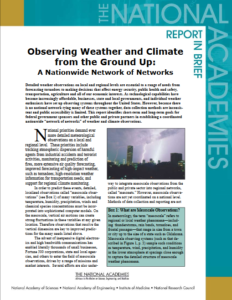From the Ground Up
The National Mesonet Program has evolved from a handful of participants into a nationwide network of networks that provides invaluable non-federal climate data to NOAA and other government organizations, to emergency planners and first responders, to researchers and to the public.
Making a Weather Ready Nation
The concept of the National Mesonet took root in 2006 when the Congressionally-directed UrbaNet program began leveraging thousands of existing local weather tracking stations that report near real-time observations to better assess and respond to potential high-threat hazards and incidents in metropolitan areas across the United States. Since that time, the National Mesonet Program (NMP) has grown to become a Program of Record within the National Oceanic and Atmospheric Administration’s (NOAA) National Weather Service (NWS), encompassing multitudes of surface in-situ networks, mobile observations, and remote sensing data to improve forecasts and support critical decisions made daily across the country. Today the NMP is recognized as an essential component of NOAA’s operations and represents a significant step toward establishment of a truly “Weather Ready Nation.”
A Nationwide Network of Networks
The ground-breaking study Observing Weather and Climate From the Ground Up: A Nationwide Network of Networks, published by the National Academy of Sciences (NAS) in 2008, laid out a challenging vision to aggregate observational data from all available sources — government, academic, and private sector, into a single unified effort. This idea included a detailed framework for improving models, forecasts, and warnings with data from the entire boundary layer and an emphasis on leveraging higher resolution and lower latency information to help solve the nation’s many daunting weather related challenges.
The Growth of the National Mesonet
In 2009, the NWS established the National Mesonet Program to centrally collect these non-federal data sets in a broad and systematic manner, enabling weather service personnel to use such valuable data to produce the best forecasts and warnings possible, helping save lives and protect property in the U.S. In the years since, the program has grown from a regional pilot project to nationwide coverage, from a small number of data providers to more than three dozen, and from a single platform type (surface in-situ) to numerous and diverse observing systems, including vertical profilers and mobile vehicle- and aircraft-mounted capabilities. During this time span, the NMP has become the truly multi-functional, multi-faceted program envisioned by the From the Ground Up report. The recent Forum on Observing the Environment From the Ground Up, sponsored jointly by the American Meteorological Society (AMS) and the Office of the Federal Coordinator of Meteorology (OFCM), highlighted the NMP’s progress. More than 100 representatives from industry, academia, and the government in attendance discussed how the nation’s observing capabilities will be further enhanced by the advancement of new sensors, communications, computing, storage, and analytical technologies. The NMP is designed and poised to take advantage of these developments.

